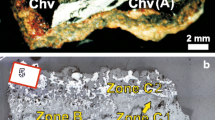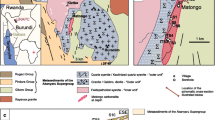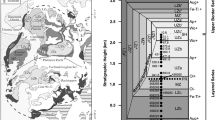Abstract
Carbonatite veinlets in fergusite from the Dunkeldyk potassium-rich basaltoid complex (southeastern Pamirs) are composed of clinopyroxene, phlogopite, and apatite phenocrysts embedded in a crystallized calcite-bearing groundmass. The examination of back-scattered electron images revealed areas of significantly different compositions in fluorapatite and fluorphlogopite. The content of BaO in the phlogopite ranges from 0.68 to 10.9 wt %. There are also variations in MgO and F contents. The maximum BaO content corresponds to high mole fractions of the Ba end member kinoshitalite (up to 0.24) in the phlogopite. The zoned fluorapatite phenocrysts are rich in SrO (0.77–25.4 wt %). An increase in SrO content is accompanied by an increase in Ce2O3, La2O3, and BaO and a distinct decrease in CaO. Most of the apatite grains are rimmed by elongated colorless crystals showing the maximum SrO contents. Based on the experimentally determined Ba and Sr partition coefficients between these minerals, silicate and carbonate melts, and fluid, a model was proposed for the enrichment of phases in these trace elements. It was shown that the mineral-forming media of the Ba-rich phlogopites was a residual melt enriched in volatiles (including F) and fluid-mobile elements. During that stage, the decomposition reactions of early Ba-bearing feldspars with subsequent incorporation of BaO in Ba-rich phlogopites played an important role. The mechanism of formation of Sr-rich apatites is fundamentally different: early apatite grains with moderate Sr contents recrystallized under the influence of Sr-rich fluids released during the late magmatic stage. Thus, despite their close association in a single rock, the Ba-bearing phlogopite and Sr-rich apatite were formed by significantly different mechanisms. Our previous investigations of melt and fluid inclusions in minerals from the rocks of the Dunkeldyk complex and the results obtained in this study allowed us to suggest that the barium, fluorite-carbonatite, and rare metal mineralization occurring in the region developed owing to the prolonged evolution of primary magmas, resulting in the formation of melt-solutions (brines) and hydrothermal systems.
Similar content being viewed by others
References
D. Velde, “Trioctahedral Micas in Melilite-Bearing Eruptive Rocks,” Carnegie Inst. Yearbook, 78, 468–475 (1979).
N. Z. Boctor and H. S. Yoder, “Petrology of Some Melilite-Bearing Rocks from Cape Province, Republic of South Africa: Relationship to Kimberlites,” Am. J. Sci. 286, 513–539 (1986).
W. D. Birch, “Mineralogy and Geochemistry of the Leucitite at Cosgrave, Victoria,” J. Geol. Soc. Austral. 25, 369–385 (1978).
R. N. Thompson, “Primary Basalts and Magma Genesis. III. Alban Hills, Roman Comagmatic Province, Central Italy,” Contrib. Mineral. Petrol. 60, 91–108 (1977).
P. M. Holm, “Mineral Chemistry of Perpotassic Lavas of the Vulsinian District, the Roman Province, Italy,” Mineral. Mag. 46, 379–386 (1982).
H. E. O’Brien, A. Irving, and I. S. McCallum, “Complex Zoning and Resorption of Phenocrysts in Mixed Potassic Mafic Magmas of the Highwood Mountains, Montana,” Am. Mineral. 73, 1007–1024 (1988).
E. A. Dunworth and M. Wilson, “Olivine Melilitites of the SW German Tertiary Volcanic Province: Mineralogy and Petrogenesis,” J. Petrol. 39, 1805–1836 (1998).
I. P. Solovova, A. V. Girnis, I. T. Rass, et al., “Different Styles of Evolution of CO2-Rich Alkaline Magmas: the Role of Melt Composition in Carbonate-Silicate Liquid Immiscibility,” Periodica Mineral. 72, 87–93 (2003).
J. P. Armstrong, M. Wilson, R. L. Barnett, et al., “Mineralogy of Primary Carbonate-Bearing Hypabyssal Kimberlite, Lac de Gras, Slave Province, Northwest Territories, Canada,” Lithos 76, 415–433 (2004).
A. D. Beard, H. Downes, E. Hegner, et al., “Mineralogy and Geochemistry of Devonian Ultramafic Minor Intrusions of the Southern Kola Peninsula, Russia: Implications for the Petrogenesis of Kimberlites and Melilitites,” Contrib. Mineral. Petrol. 130, 288–303 (1998).
A. D. Beard, H. Downes, E. Hegner, and S. M. Sablukov, “Geochemistry and Mineralogy of Kimberlites from the Arkhangelsk Region, NW Russia: Evidence for Transitional Kimberlite Magma Types,” Lithos 51, 47–73 (2000).
L. N. Kogarko, G. Kurat, and T. Ntaflos, “Carbonate Metasomatism of the Oceanic Mantle beneath Fernando de Noronha Island, Brazil,” Contrib. Mineral. Petrol. 140, 577–587 (2001).
L. N. Kogarko, Y. A. Uvarova, E. Sokolova, et al., “Oxykinoshitalite, a New Species of Mica from Fernando de Noronha Island, Pernambuco, Brazil: Occurrence and Crystal Structure,” Can. Mineral. 43, 1501–1510 (2005).
L. N. Kogarko, G. Kurat, and T. Ntaflos, “Henrymeyerite in the Metasomatized Upper Mantle of Eastern Antarctica,” Can. Mineral. 45, 497–501 (2007).
A. R. Chakhmouradian, E. P. Reguir, and R. H. Mitchell, “Strontium-Apatite: New Occurrences and the Extent of Sr for Ca Substitution in Apatite-Group Minerals,” Can. Mineral. 40, 121–136 (2002).
A. D. Edgar, “Barium- and Strontium-Enriched Apatites in Lamproites from West Kimberley, Western Australia,” Am. Mineral. 74, 889–895 (1989).
J. F. Rakovan and J. M. Hughes, “Strontium in the Apatite Structure: Strontian Fluorapatite and Belovite-(Ce),” Can. Mineral. 38, 839–845 (2000).
I. P. Solovova, A. V. Girnis, A. V. Guzhova, and V. B. Naumov, “Magmatic Salt Inclusions in the Minerals of Alkali Basalts from the Eastern Pamirs,” Geokhimiya, No. 1, 68–77 (1992).
I. P. Solovova, A. V. Girnis, and I. D. Ryabchikov, “Inclusions of Carbonate and Silicate Melts in Minerals of Alkali Basaltoids from the East Pamirs,” Petrologiya 4, 339–363 (1996) [Petrology 4, 118–136 (1996)].
I. P. Solovova, A. V. Girnis, I. D. Ryabchikov, and S. G. Simakin, “High-Temperature Carbonatite Melt and Its Interrelations with Alkaline Magmas of the Dunkelídyk Complex, Southeastern Pamirs,” Dokl. Akad. Nauk 409, 1–4 (2006) [Dokl. Earth Sci. 410, 1148–1151 (2006)].
E. A. Dmitriev, Cenozoic Potassic Rocks of the Eastern Pamirs (Donish, Dushanbe, 1976) [in Russian].
B. Hacker, P. Luffi, V. Lutkov, et al., “Near-Ultrahigh Pressure Processing of Continental Crust: Miocene Crustal Xenoliths from the Pamirs,” J. Petrol. 46, 1661–1687 (2005).
J. Guo and T. H. Green, “Experimental Study of Barium Partitioning between Phlogopite and Silicate Liquid at Upper Mantle Pressure and Temperature,” Lithos 24, 83–95 (1990).
K. Righter and I. S. Carmichael, “Phase Equilibria of Phlogopite Lamprophyres from Western Mexico: Biotite-Liquid Equilibria and P-T Estimates for Biotite-Bearing Igneous Rocks,” Contrib. Mineral. Petrol. 123, 1–21 (1996).
K. H. Schmidt, P. Bottazzi, R. Vannucci, and K. Mengel, “Trace Element Partitioning between Phlogopite, Clinopyroxene and Leucite Lamproite Melt,” Earth Planet. Sci. Lett. 168, 287–299 (1999).
W. L. Mansker, R. C. Ewing, and K. Keil, “Barian-Titanian Biotites in Nephelinites from Oahu, Hawaii,” Am. Mineral. 64, 156–159 (1979).
D. S. Korzhinskii, “Acid-Base Interaction in Mineral-Forming Systems,” in Selected Works (Nauka, Moscow, 1994) [in Russian].
R. J. Sweeney, T. J. Falloon, and D. H. Green, “Experimental Constraints on the Possible Mantle Origin of Natrocarbonatite,” in Carbonatite Volcanism: Oldoinyo Lengai and the Petrogenesis of Natrocarbonatites, Ed. by K. Bell and J. Keller, IAVCEI Proceedings in Volcanology 4 (Berlin, 1995), pp. 191–207.
B. A. Kjarsgaard, D. L. Hamilton, and T. D. Peterson, “Peralkaline Liquid Immiscibility: Comparison of Phase Compositions in Experiments and Natural Lavas from Oldoinyo Lengai,” in Carbonatite Volcanism: Oldoinyo Lengai and the Petrogenesis of Natrocarbonatites, Ed. by K. Bell and J. Keller, IAVCEI Proceedings in Volcanology 4 (Berlin, 1995), pp. 163–190.
B. A. Kjarsgaard, “Phase Relations of a Carbonated High-CaO Nephelinite at 0.2 and 0.5 GPa,” J. Petrol. 39, 2061–2075 (1998).
I. V. Veksler, C. Petibon, G. A. Jenner, et al., “Trace Element Partitioning in Immiscible Silicate-Carbonate Liquid Systems: An Initial Experimental Study Using a Centrifuge Autoclave,” J. Petrol. 39, 2095–2104 (1998).
E. B. Watson and T. H. Green, “Apatite/Liquid Partition Coefficients for the Rare Earth Elements and Strontium,” Earth Planet. Sci. Lett. 56, 405–421 (1981).
S. Prowatke and S. Klemme, “Trace Element Partitioning between Apatite and Silicate Melts,” Geochim. Cosmoch. Acta 70, 4513–4527 (2006).
S. Klemme and C. Dalpe, “Trace-Element Partitioning between Apatite and Carbonatite Melt,” Am. Mineral. 88, 639–646 (2003).
I. C. Freestone and D. L. Hamilton, “The Role of Liquid Immiscibility in the Genesis of Carbonatites: An Experimental Study,” Contrib. Mineral. Petrol. 73, 105–117 (1980).
J. C. Ayers and E. B. Watson, “Apatite/Fluid Partitioning of Rare-Earth Elements and Strontium: Experimental Results at 1.0 GPa and 1000°C and Application to Models of Fluid-Rock Interaction,” Chem. Geol. 110, 299–314 (1993).
C. Zhou, C. Wei, J. Guo, and C. Li, “The Source of Metals in the Qilinchang Zn-Pb Deposit, Northeastern Yunnan, China: Pb-Sr Isotope Constraints,” Econ. Geol. 96, 583–598 (2001).
N. P. Laverov, V. Yu. Prokof’ev, V. V. Distler, et al., “New Data on Conditions of Ore Deposition and Composition of Ore-Forming Fluids in the Sukhoi Log Gold-Platinum Deposit,” Dokl. Akad. Nauk 371, 88–92 (2000) [Dokl. Earth Sci. 371, 357–361 (2000)].
J. Najorka, M. Gottschalk, G. Franz, and W. Heinrich, “Ca-Sr Distribution among Amphibole, Clinopyroxene, and Chloride-Bearing Solutions,” Am. Mineral. 84, 596–606 (1999).
A. Nagasaki and E. Masaki, “Sr-Bearing Zoisite and Epidote in Ultra-High Pressure (UHP) Metamorphic Rocks from the Su-Lu Province, Eastern China: An important Sr reservoir under UHP conditions,” Am. Mineral. 8, 240–247 (1998).
Y. Tatsumi and T. Kogiso, “Trace Element Transport during Dehydration Processes in the Subducted Oceanic Crust: 2. Origin of Chemical and Physical Characteristics in Arc Magmatism,” Earth Planet. Sci. Lett. 148, 207–221.
B. Wunder and S. Melzer, “Interlayer Vacancy Characterization of Synthetic Phlogopitic Micas by IR Spectroscopy,” Eur. J. Mineral. 14, 1129–1138 (2002).
H. E. Frimmel, D. Hoffmann, R. T. Watkins, and J. M. Moore, “An Fe Analogue of Kinoshitalite from the Broken Hill Massive Sulfide Deposit in the Namaqualand Metamorphic Complex, South Africa,” Am. Mineral. 80, 833–840 (1995).
S. Dasgupta, S. Chakraborti, P. Sengupta, et al., “Compositional Characteristics of Kinoshitalite from the Sausar Group, India,” Am. Mineral. 74, 200–202 (1989).
G. Tischendorf, H.-J. Förster, and B. Gottesmann, “Minor- and Trace-Element Composition of Trioctahedral Micas: A Review,” Mineral. Mag. 65, 249–276 (2001).
I. D. Ryabchikov, Thermodynamics of Fluid Phase of Granitoid Magmas (Nauka, Moscow, 1975) [in Russian].
J. D. Webster, “Partitioning of F between H2O and CO2 Fluids and Topaz Rhyolite Melt,” Contrib. Mineral. Petrol. 104, 424–438 (1990).
A. Aiuppa, C. Federico, G. Giudice, et al., “Plume Chemistry Provides Insights Into Mechanisms of Sulfur and Halogen Degassing in Basaltic Volcanoes,” Earth Planet. Sci. Lett. 222, 469–483 (2004).
S. F. Foley, D. S. Musselwhite, and S. R. van der Laan, “Melt Compositions from Ultramafic Vein Assemblages in the Lithospheric Mantle: A Comparison of Cratonic and Non-Cratonic Settings,” in The J. Dawson Volume. Proceedings of 7th International Kimberlite Conference, Cape Town, South Africa, 1999 (Red Roof Design, Cape Town, 1999), pp. 238–246
E. H. Hauri, T. P. Wagner, and T. G. Grove, “Experimental and Natural Partitioning of Th, U, Pb and Other Trace Elements between Garnet, Clinopyroxene and Basaltic Melts,” Chem. Geol. 117, 149–166 (1994).
B. J. Wood and J. D. Blundy, “Trace Element Partitioning under Crustal and Uppermost Mantle Conditions: The Influences of the Ionic Radius, Cation Charge, Pressure, and Temperature,” in Treatise on Geochemistry (Elsevier, Amsterdam, 2003), Vol. 2, pp. 395–424.
M. Becker and A. P. le Roex, “Geochemistry of South African On- and Off-Craton, Group I and Group II Kimberlites: Petrogenesis and Source Region Evolution,” J. Petrol. 47, 673–703 (2006).
A. W. Hofmann, “Mantle Geochemistry: the Message from Oceanic Volcanism,” Nature 385, 219–229 (1997).
I. D. Ryabchikov and A. V. Girnis, “Conditions and Mechanisms of Generation of Kimberlite Magmas,” Geol. Rudn. Mestorozhd. 4, 524–536 (2005) [Geol. Ore Dep. 4, 476–487 (2005).
Author information
Authors and Affiliations
Corresponding author
Additional information
Original Russian Text © I.P. Solovova, A.V. Girnis, I.D. Ryabchikov, N.N. Kononkova, 2009, published in Geokhimiya, 2009, No. 6, pp. 613–627.
Rights and permissions
About this article
Cite this article
Solovova, I.P., Girnis, A.V., Ryabchikov, I.D. et al. Mechanisms of formation of barium-rich phlogopite and strontium-rich apatite during the final stages of alkaline magma evolution. Geochem. Int. 47, 578–591 (2009). https://doi.org/10.1134/S0016702909060044
Received:
Published:
Issue Date:
DOI: https://doi.org/10.1134/S0016702909060044




